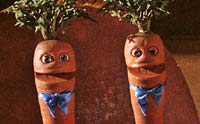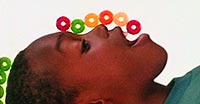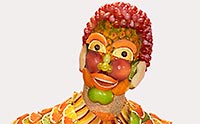Tattoo Parlor Diorama

Leaning against a parked Harley-Davidson chopper is a woman, who is adorned in nothing but inked images. She gestures toward the doorway of the Living Art Tattoo Parlor. This was the concept for a piece I created in 1985 using the unique art form known as Shadowbox Diorama. Projects of this type require extensive planning and a range of skills, including painting, sculpture, model-making, staging, design, craftsmanship, and custom lighting. It was quite a challenge to produce!


The woman's tattoos were crucial to the success of this project. In those days, tattoos were still considered fringe and reference sources were scarce, so I had to do extensive research on the subject. However, I didn't want to merely imitate the typical subjects that people get tattooed on their bodies in a piecemeal fashion. Since I was creating an illustrated woman, I decided to take a holistic approach and treat the entire skin of the body as my canvas. I designed the tattoos based on alchemy and symbolism to create an overall cohesive design. Unfortunately, my canvas was not a real woman, but a miniature one!
To speed up the process, I decided to use parts from a couple Aurora figure kits to create the basic form of the woman rather than sculpting her from scratch. I cut up and reassembled the plastic parts in a Frankenstein-like fashion to create the required pose. I filed away unneeded clothing and improved the body and facial contours. Epoxy putty was applied and sculpted into a voluptuous figure to fit my vision. The sculpture was carefully sanded, primed, and airbrushed with lacquer paint to create the overall flesh tone. I really enjoyed tattooing the miniature woman in oil paint using very tiny brushes. It was definitely the most enjoyable part of the project for me. I used hair from a doll to finish off the woman.

The chopper was created by kitbashing two Revell motorcycle model kits to create a unique look. It was airbrushed in white pearl lacquer, and then I hand-painted custom designs on the gas tank. After the featured woman and chopper were finished, I moved on to the storefront set which was designed around them. I used plywood for the wall and floor framework and adapted 1/12 scale dollhouse components and accessories for the finish work. I hand-painted a stained glass window in a symbolic peacock motif for the door. The main window was lettered with Letraset transfers and the sill was decorated with tattoo-related props, while curtains obscured what was beyond it.
Real working lights added a sense of realism, mood, and atmosphere to the piece. The wall sconces had tiny grain of wheat bulbs, and the door and window were illuminated from behind by automotive dashboard lights. Additionally, a hidden light was installed from above to spotlight the figure and motorcycle. Since these lights had different voltage requirements, I installed two transformers in the back to convert the AC current.
The shadowbox housing and the diorama were designed to fit together seamlessly. I used a traditional picture frame for the front of the box, and attached sides of wood stained to match the frame. Inside, I installed wood rails to support the diorama, which could be slid into place and locked snugly against the glass in the picture frame.


When viewed from the vantage point of its picture frame, the finished shadowbox diorama gives the illusion of an illuminated three-dimensional painting. I was very pleased with the final results of my labors and planned to create another piece in this fascinating art form. Unfortunately, it never progressed beyond the planning stages and now, many years later, my Tattoo Parlor diorama remains the only one I made in that genre.







































